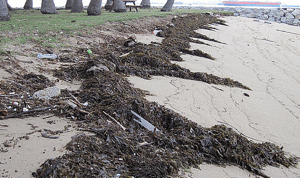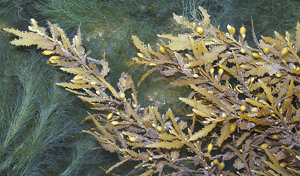The Need for Seaweed
Air Date: Week of July 16, 2010

Beaches full of washed up sargassum are a common sight in many coastal areas. (wildsingapore)
Sargassum seaweed is a critically important habitat for hundreds of marine species. The plant originates in the Gulf of Mexico and is carried by ocean currents to the Sargasso Sea off the eastern seaboard. University of South Alabama marine scientist Bob Shipp tells host Jeff Young that scientists are concerned that oil in the Gulf is killing the sargassum and other marine life.
Transcript
YOUNG: The Sargasso Sea is fixed in nautical lore—it’s that patch of calm water near the Caribbean where sargassum seaweed collects in vast mats. But most of the sargassum of the Sargasso Sea really comes from the Gulf of Mexico, where the brown algae with little pea sized air pockets grows like crazy. And it’s there in the Gulf that marine scientist Bob Shipp is anxiously monitoring the sargassum weed that is now mixed with BP’s oil. Professor Shipp teaches at the University of South Alabama where he studies how the sargassum supports an entire ecosystem.
SHIPP: The Gulf has the second largest concentration of sargassum of any ocean in the world. A fair amount of it washes out through the straights of Florida on the Gulf Stream and ends up in the Sargasso Sea in the Atlantic Ocean off the East Coast of the United States.

The Sargasso Sea is not a sea at all but a calm area where several ocean currents come together to trap sargassum seaweed in huge dense mats 2,000 miles long. (http://www.Iliketolearn.com)
YOUNG: What is it about the Gulf that makes it produce so much of this stuff?
SHIPP: One has to speculate it’s just the environment, it’s just a combination of high salinity, clear water, and yet enough nutrients in the water to support the proliferation of the Sargassum. It’s just the ideal condition for it. At least until the oil hit.
YOUNG: So what does this mean if the oil is now mixed in with the sargassum?
SHIPP: Well, it’s unfortunate because sargassum almost acts like a sponge, it just soaks up the oil, and the sargassum is relatively delicate. Once the oil hits it, it’ll block out sunlight, it’ll essentially suffocate the sargassum and it will kill it. And when it does it kills all the biota, all the life, that is dependent on the sargassum- and there is a lot of that.
YOUNG: Well, tell me about the other species in the Gulf that depend on sargassum.

The Genus name sargassum comes from a Portuguese grape. Early explorers thought the round floats on the seaweed looked like the grapes they knew from home. (Photo: wildsingapore)
SHIPP: I think the best analogy is to think of the sargassum the same way one would think of marshes and sea grasses in estuaries. The sargassum is a major, major habitat. It provides cover for literally hundreds of species, not just fin-fishes, but crustaceans and other organisms as well. If you run a camera up under sargassum you just see a plethora of different species.
One of my colleagues recently sampled some sargassum and a whole vial full of larval blue fin tuna came out. So, many species lay their eggs on sargassum, many species depend on it for forage, for cover, especially in their early life phases. The highly migratory species like the tunas and the billfish and the dolphin fish, they all depend on that sargassum the same way that, near-shore, our blue crabs and flounders depend on sea grasses.
YOUNG: What’s the likely impact on those species that depend on this little floating ecosystem?
SHIPP: They’re totally dependent on it. If the sargassum goes, they go. Now fortunately, only about a third of the gulf has been impacted by the oil, so, there are vast areas of sargassum that are untouched in the Gulf. But, for those areas that have the sargassum covered with oil, it’s going to take quite a long time for the other areas of sargassum to come back and replenish those areas of the Gulf that have lost their sargassum. Unfortunately, species like the blue fin tuna for example, they don’t spawn gulf-wide, they spawn in very selected areas and so, the sargassum that is lost is also going to cause the loss of that whole year-class of blue fin tuna, and other species as well.

Beaches full of washed up sargassum are a common sight in many coastal areas. (Photo: wildsingapore)
YOUNG: How did you end up studying this weed anyway?
SHIPP: [laughs] Those of us who are fisheries biologists are well aware of how important the sargassum is. As soon as this spill became public, one of the first things we did was send vessels out sampling the sargassum that has not been impacted so we have a baseline. We wanted to quantify the populations in the un-impacted sargassum so when it did become impacted we could make those comparisons.
YOUNG: And, what have you been able to quantify thus far by way of impact, comparing it to the baseline data you collected? What do we know about just how bad it is?
SHIPP: Well, we’ve taken a number of sargassum samples that do have the oil in it. Most of the species are absent if the sargassum has oil. Some of the other species are confusing the oil globs for sargassum and they’re tying to hide in the oil globs, which of course renders them fatal in the long run. We don’t have real strong numbers right yet, but we will when this is all said and done.
YOUNG: Are there parallels in earlier spills or oil incidents that might give us some indication as to what to expect by way of impact here?
SHIPP: Well, you know, the first one thinks about is Valdez, and these many years later, 20-some years later, several species have never recovered in the Valdez area because of the impact on the habitat. The sardines, for example, the pacific sardines, which are dependent on vegetation in Valdez, never recovered, they never came back because that habitat never came back. I think the parallel here is with the sargassum. It will eventually come back, and when it does, these species will probably recover as well, but it’s not going to happen overnight, it’s not going to happen next year. It’s going to take a number of years for it to recover.
YOUNG: Professor Bob Shipp at University of South Alabama, thank you very much!
SHIPP: Oh, you’re most welcome. I appreciate you having me on.
Links
Click Here to see a Clip of Sea Life that Lives Under Sargassum
Living on Earth wants to hear from you!
Living on Earth
62 Calef Highway, Suite 212
Lee, NH 03861
Telephone: 617-287-4121
E-mail: comments@loe.org
Newsletter [Click here]
Donate to Living on Earth!
Living on Earth is an independent media program and relies entirely on contributions from listeners and institutions supporting public service. Please donate now to preserve an independent environmental voice.
NewsletterLiving on Earth offers a weekly delivery of the show's rundown to your mailbox. Sign up for our newsletter today!
 Sailors For The Sea: Be the change you want to sea.
Sailors For The Sea: Be the change you want to sea.
 The Grantham Foundation for the Protection of the Environment: Committed to protecting and improving the health of the global environment.
The Grantham Foundation for the Protection of the Environment: Committed to protecting and improving the health of the global environment.
 Contribute to Living on Earth and receive, as our gift to you, an archival print of one of Mark Seth Lender's extraordinary wildlife photographs. Follow the link to see Mark's current collection of photographs.
Contribute to Living on Earth and receive, as our gift to you, an archival print of one of Mark Seth Lender's extraordinary wildlife photographs. Follow the link to see Mark's current collection of photographs.
 Buy a signed copy of Mark Seth Lender's book Smeagull the Seagull & support Living on Earth
Buy a signed copy of Mark Seth Lender's book Smeagull the Seagull & support Living on Earth

